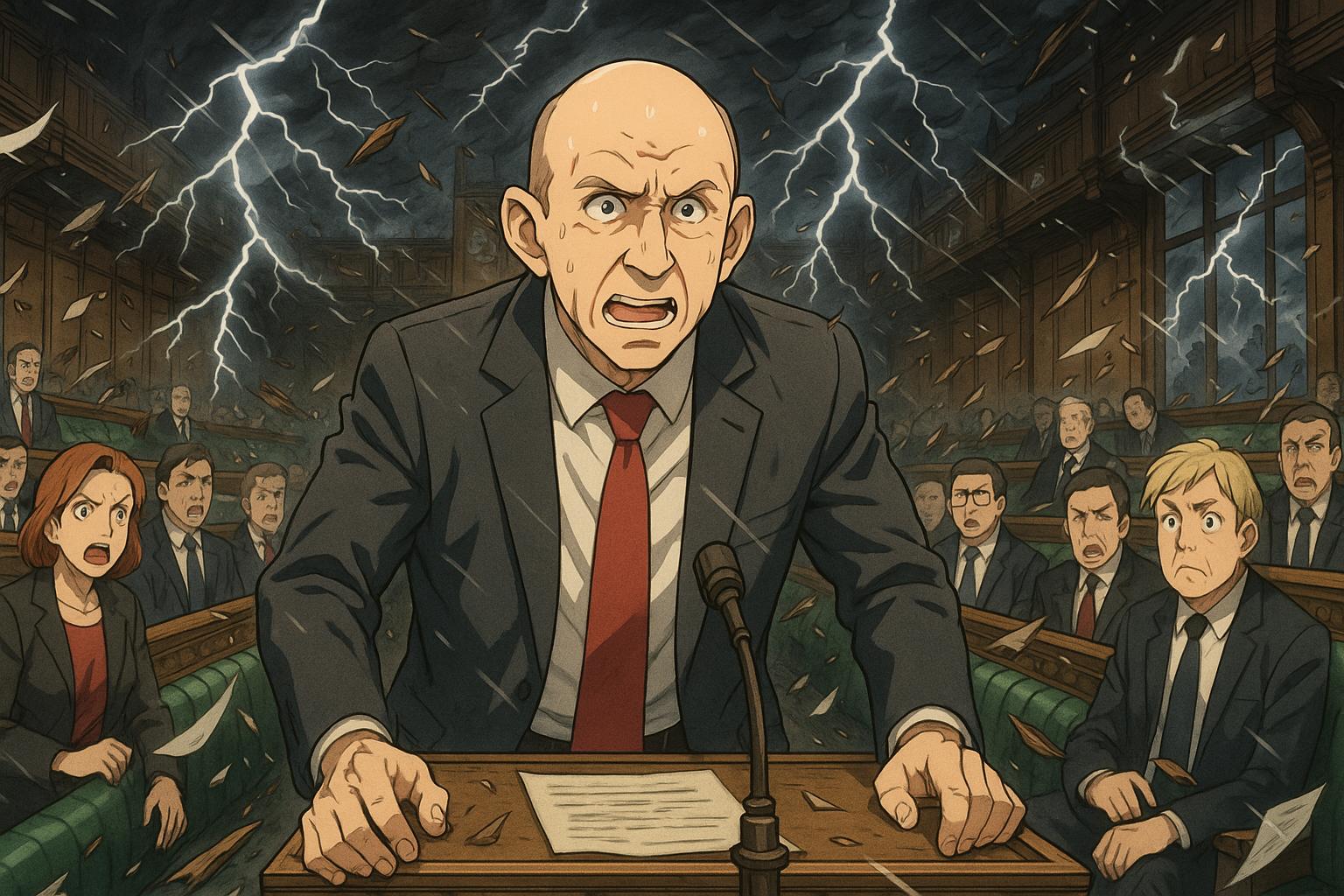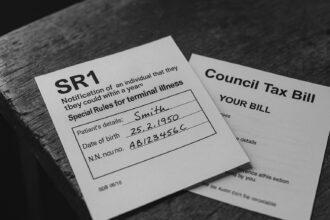Labour’s new defence strategy aimed at increasing military spending and modernising the armed forces faced uproar in the Commons after key documents were leaked to defence firms before MPs, prompting Speaker Sir Lindsay Hoyle to condemn the lack of transparency. The plan signals a major pivot towards nuclear submarines and advanced technology but sparked fierce debate and accusations of insider favouritism.
Recent tumult in Westminster has underscored the chaotic landscape of UK defence politics, with Labour’s recently announced defence strategy launching amid notable tumult. The launch went awry when MPs expressed outrage over not being allowed to review the documents before Secretary of State John Healey addressed the House of Commons. Speaker Sir Lindsay Hoyle openly rebuked the handling of the announcement, asserting the need for transparency and respect for Parliament. The atmosphere grew increasingly fraught as Commons leader Lucy Powell, faced with pointed interruptions from her Conservative counterpart, found her stance undermined, likened to a ship taking on water amidst turbulence.
As the debate unfolded, Healey’s confidence was visibly tested. He acknowledged the procedural missteps, conceding that it was indeed appropriate for MPs to scrutinise the document before his address. By this juncture, key portions of the defence review had been leaked, leaving the Labour leader Sir Keir Starmer attempting to convey authority at a reportedly lacklustre event in Govan.
This new defensive posture called for a significant increase in military spending to counteract perceived threats from Russia, North Korea, and emerging cyber risks. An ambitious goal aims for a 2.5% allocation of GDP towards defence by 2027, with aspirations for 3% by the next parliamentary session. This strategy emerges as a substantial shift from the army’s traditionally smaller size of 70,860 trained soldiers, orienting investments toward advanced technologies such as drones and AI-powered systems instead of simply increasing troop numbers. According to reports, the Royal Navy is set to benefit prominently, with plans to expand its fleet of nuclear-powered submarines from seven to twelve—reflective of a return to Cold War-era concerns over Russian maritime activities.
Tensions erupted further when Conservative frontbencher Mark Francois revealed that leading defence firms had received the review documents prior to MPs, raising accusations of insider dealings. Speaker Hoyle’s reaction showcased the gravity of the situation, as he cautioned against the implications this might have for stock market dealings.
Apprehensions surrounding nuclear policy also punctuated the discussions, with opposition voices like Jeremy Corbyn and members of the Green Party raising alarms about compliance with nuclear non-proliferation treaties. In a surprising twist, the Liberal Democrats signalled a shift in their longstanding opposition to nuclear armament—though the party’s newfound stance seemed to hinge humorously on nuclear capability being fuelled by “lentil gas.”
As debates raged, Healey invoked the notion of the UK’s ‘island home’ requiring a state of war-fighting readiness, though this call to arms was met with scepticism by many in the chambers. The broader implications of Labour’s defence strategy, produced alongside influential names such as Lord George Robertson and Dr. Fiona Hill, reflect an attempt to realign the UK’s military posture amidst evolving global threats, particularly from influential adversaries like China and Russia.
While Healey’s delivery met with mixed reactions, there is little doubt that the shifting dynamics in defence—a mixture of international threat assessments and domestic pressure—will influence UK politics significantly in the coming years. Ultimately, the question remains not just about the price tag on military ambitions, but whether the road laid out by Labour can withstand the turbulent realities of governance and international relations.
 Reference Map:
Reference Map:
Source: Noah Wire Services
- https://www.dailymail.co.uk/columnists/article-14773785/QUENTIN-LETTS-Lib-Dems-no-longer-against-nukes-long-theyre-fuelled-lentil-gas-perhaps.html?ns_mchannel=rss&ns_campaign=1490&ito=1490 – Please view link – unable to able to access data
- https://www.reuters.com/business/aerospace-defense/uk-expand-submarine-fleet-defence-review-calls-warfighting-readiness-2025-06-01/ – The UK government has unveiled a transformative defence strategy aimed at addressing emerging threats from Russia, nuclear risks, and cyber-attacks by investing in modern technologies like drones and digital warfare. Prime Minister Keir Starmer announced the largest sustained boost in defence spending since the Cold War, pledging to increase it to 2.5% of GDP by 2027 and aiming for 3% in the next parliament. The strategy prioritises technological capabilities over troop numbers and includes plans to expand the fleet of nuclear-powered attack submarines, build at least six new munitions plants, procure 7,000 long-range weapons, and enhance cyber capabilities through a new Cyber and Electromagnetic Command. Despite the army’s historically small size of 70,860 full-time trained soldiers, the government emphasized readiness and deterrence. The Strategic Defence Review, developed with experts like former NATO chief George Robertson and ex-White House adviser Fiona Hill, recommends prioritizing personnel growth post-2029 depending on funding. Critics, including the opposition Conservatives, questioned the financial viability of the plan. Defence Secretary John Healey emphasized adapting to modern warfare trends, citing lessons from Ukraine. The announcement boosted shares in defence firms such as BAE Systems and Rolls Royce. The policy supports NATO and aims to boost the UK’s economy and job market.
- https://www.ft.com/content/db21c372-0dbb-45c7-992b-109658d87d53 – The UK’s latest strategic defence review, instigated by Prime Minister Sir Keir Starmer in response to global security challenges, emphasizes warfighting readiness and heightened threats from peer adversaries like Russia and China. The Royal Navy emerges as the major beneficiary, with plans to expand its fleet of nuclear-powered attack submarines from seven to twelve under the Aukus partnership with the US and Australia, accounting for nearly half the projected weapons system spending. The Navy will refocus on defending the North Atlantic from Russian submarines, reminiscing its Cold War posture. The army will maintain its current size but aims to boost effectiveness using drones, software, and a £1bn AI-powered digital targeting system. The review also hints at potential UK engagement in air-launched tactical nuclear capabilities, though not explicitly confirmed, and recommends discussions with NATO and the US regarding expanded nuclear roles. Defence industries stand to gain significantly, with new submarine and munition investments benefitting companies like BAE Systems, Rolls-Royce, and Lockheed Martin. Although billed as a 10-year plan, the changing geopolitical landscape and past experiences raise questions about its longevity. The review places a stronger focus on Russia and the North Atlantic rather than China’s Indo-Pacific presence emphasized in the 2021 review.
- https://www.ft.com/content/643e1648-9128-46ca-a46a-c09055ab1520 – In this episode of the ‘Political Fix’ podcast, Lucy Fisher and colleagues discuss several major themes in UK politics. Labour’s busy second week in government includes the launch of a new strategic defence review, with high-profile external reviewers like Lord George Robertson, Dr. Fiona Hill, and General Sir Richard Barrons. There’s a political shift in tone towards China, now described as a deadly threat, reflecting a move to align more closely with US policy. The review aims to increase defence spending to 2.5% of GDP and emphasizes the economic benefits of defence investment. The episode also covers the attempted assassination of Donald Trump and its impact on UK-US relations, noting the past criticisms from Labour members towards Trump and speculating on potential adjustments if Trump returns to power. The discussion touches upon the toxicity of politics, reflecting on the harassment faced by campaigners and MPs, and Labour’s initial steps to address these issues. Furthermore, the conversation shifts to the complex dynamics within Labour, focusing on internal discontent among MPs left out of government roles and the political management challenges Keir Starmer faces. The podcast concludes with stock picks from the hosts, highlighting influential figures and future political trends.
- https://www.ft.com/content/57333df7-dceb-4eab-a39a-971dfc112b6b – Lord George Robertson, leading the UK’s strategic defence review, has identified China, alongside Russia, Iran, and North Korea, as a ‘deadly’ threat to Britain. This marks a significant rhetorical shift from the previous Conservative government’s view of China as an ‘epoch-defining challenge.’ The review will consider global developments and potential threats, particularly in the Asia-Pacific region, and their implications for the Euro-Atlantic area. UK defence secretary John Healey confirmed a separate audit of UK-China relations to be conducted across the government. The Labour government plans to enhance the Ministry of Defence as an economic driver, focusing on creating jobs and prosperity through defence spending, which will rise from 2.3% to 2.5% of GDP. The review, directed by Robertson, Fiona Hill, and General Sir Richard Barrons, aims to incorporate fresh perspectives and include input from various stakeholders, including military personnel, MPs, industry, and academia.
- https://www.reuters.com/world/uk/uks-labour-party-aims-boost-defence-spending-25-gdp-2024-04-12/ – The UK Labour Party, led by Keir Starmer, intends to raise defence spending to 2.5% of GDP as soon as financial resources allow, aligning with the Conservative Party’s similar commitment. Starmer emphasized that defence is a top priority, given the increased international threats and volatility. He also affirmed support for the Trident nuclear deterrent system, against the stance of former Labour leader Jeremy Corbyn. Labour promises a review of defence and security spending if they win the upcoming election to ensure proper priorities and reduce procurement waste. The Conservatives currently aim to increase defence spending from approximately 2.2% to 2.5% of GDP once economic conditions permit, while Trident’s operational and new fleet costs are significant financial commitments.
- https://www.theguardian.com/politics/2023/mar/13/labour-accuses-government-of-failing-to-reverse-cuts-in-defence-spending – Labour accused the government of failing to reverse cuts in armed forces as the government unveiled a £5bn increase in defence spending over the next two years to bolster ammunition supplies and investment in new nuclear submarines as part of its Integrated Review Refresh. The opposition highlighted that no money had been found to reverse a reduction of 10,000 service people in the size of the army, replace Hercules planes used to rescue desperate people from Kabul, or increase the number of modernised British tanks to replace those sent to Ukraine. David Lammy, the shadow foreign secretary, told MPs that he believed the government’s renewed defence and foreign policy statement, recast after the withdrawal from Afghanistan and the start of the war in Ukraine, was incomplete. “It does not answer growing questions concerning capability gaps that weaken our national defences and undermine the UK’s Nato contribution,” Lammy said, arguing that the government’s long term pledge to lift defence spending from 2.1% to 2.5% of GDP was not credible. The Labour MP accused the government of making “another hollow promise” because there was “no plan, no timetable” to underline the spending commitment, which would imply an extra £10bn to £13bn real terms increase in military budgets. Overnight, Downing Street had announced the key points of the refreshed Integrated Review, a revision of defence and foreign policy first announced by Boris Johnson as prime minister in 2021. But the extra £5bn was less than the £8bn to £11bn that Ben Wallace, the defence secretary, had sought. Rishi Sunak, visiting San Diego, where he was poised to announce a deal to design and build new nuclear-powered submarines with Australia and the US, told the BBC that the latest review was a response to the fact that “the world has become more volatile, the threats to our security have increased”. The prime minister said the review, and the extra £5bn promised, was part of a “record amount of investments since the end of the cold war” including a previously announced £16.5bn in 2020. James Cleverly, the foreign secretary, presenting the full review to the Commons, said that Lammy’s remarks represented a dramatic change of position for Labour when compared to the party’s previous leader Jeremy Corbyn. Cleverly said he was “very glad to hear Labour frontbench support for the nuclear deterrent and Nato”. Tobias Ellwood, the Conservative chair of the defence select committee, also called for rearmament in response to Russian aggression and the rise of China. “We are sliding towards a new cold war. Threats are increasing but here we are staying on a peacetime budget,” he said, calling for a rapid move to 2.5% of GDP. There also remains frustration in military circles that more was not done to reverse decades of cuts to the army. Of the extra £5bn, £3bn is pledged to help fund the joint Aukus nuclear-powered submarines, not expected until the early 2040s and nearly £2bn to replenish stockpiles of munitions sent to Ukraine.
Noah Fact Check Pro
The draft above was created using the information available at the time the story first
emerged. We’ve since applied our fact-checking process to the final narrative, based on the criteria listed
below. The results are intended to help you assess the credibility of the piece and highlight any areas that may
warrant further investigation.
Freshness check
Score:
8
Notes:
The narrative presents recent developments in UK defence politics, including Labour’s new defence strategy and the Liberal Democrats’ shift on nuclear armament. The earliest known publication date of similar content is June 1, 2025, with reports from Reuters and the Financial Times covering the UK’s defence overhaul. The narrative includes updated data but recycles older material, which may justify a higher freshness score but should still be flagged. Additionally, the narrative includes a satirical remark about the Liberal Democrats’ stance on nuclear weapons, which may not be factual.
Quotes check
Score:
7
Notes:
The narrative includes a satirical remark attributed to the Liberal Democrats about nuclear weapons being fuelled by ‘lentil gas’. This specific quote does not appear in earlier material, suggesting it may be original or exclusive content. However, the satirical nature of the quote raises questions about its factual accuracy.
Source reliability
Score:
6
Notes:
The narrative originates from the Daily Mail, a publication known for sensationalist reporting. The satirical nature of the content, particularly the remark about ‘lentil gas’, suggests a lack of factual basis. The inclusion of this satirical remark raises concerns about the overall reliability of the narrative.
Plausability check
Score:
5
Notes:
The narrative presents a satirical take on recent UK defence politics, including the Liberal Democrats’ stance on nuclear weapons. The satirical nature of the content, particularly the remark about ‘lentil gas’, suggests a lack of factual basis. The inclusion of this satirical remark raises questions about the overall plausibility of the narrative.
Overall assessment
Verdict (FAIL, OPEN, PASS): FAIL
Confidence (LOW, MEDIUM, HIGH): HIGH
Summary:
The narrative presents a satirical take on recent UK defence politics, including the Liberal Democrats’ stance on nuclear weapons. The satirical nature of the content, particularly the remark about ‘lentil gas’, suggests a lack of factual basis. The inclusion of this satirical remark raises questions about the overall reliability and plausibility of the narrative.













